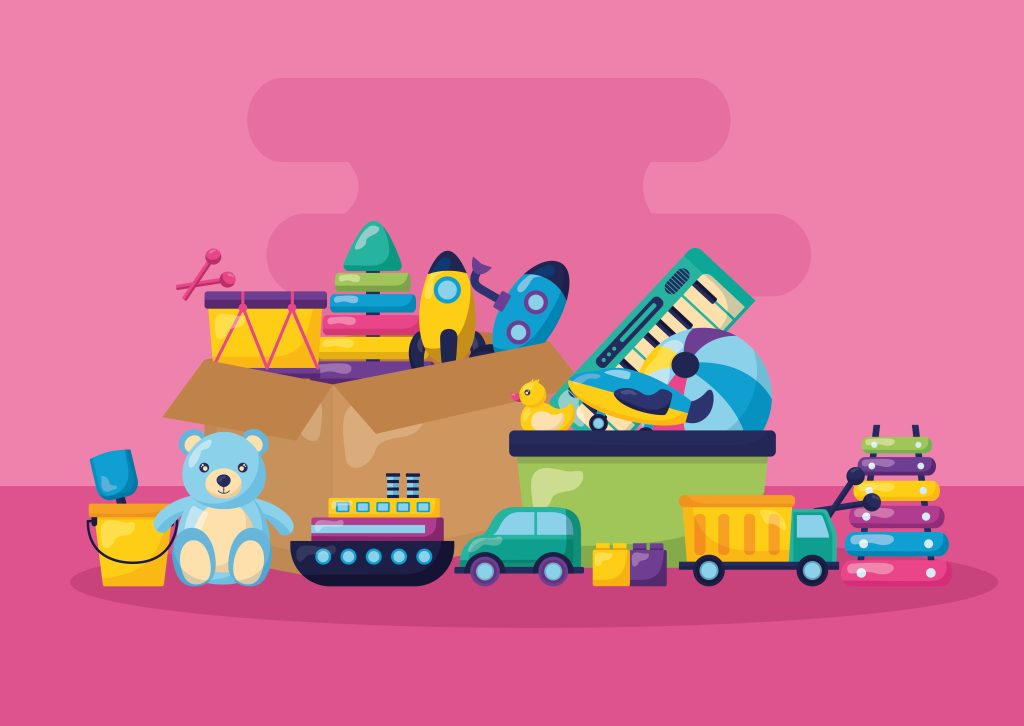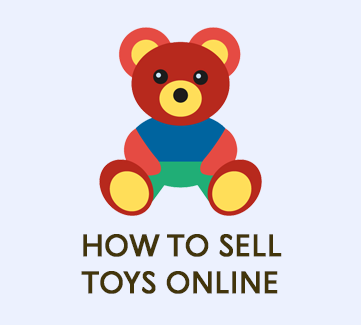Selling toys online is an exciting and potentially lucrative venture, especially with the growing demand for unique, high-quality, and educational toys. Whether you’re a small business owner, a toy manufacturer, or someone with a passion for toys looking to turn a hobby into a business, selling toys online can open up a world of opportunities.
Here’s a step-by-step guide to help you navigate the process.

10 Steps to Start Selling Toys Online
Research the Market
Before diving into the world of online toy sales, it’s crucial to conduct thorough market research. Understand the trends in the toy industry, identify your target audience, and analyze your competitors. Key areas to focus on include:
✓ Popular toy categories
Educational toys, action figures, dolls, funko pops, puzzles, and eco-friendly toys.
✓ Target demographics
Age groups, gender preferences, and parental buying behaviors.
✓ Seasonal trends
Holidays, birthdays, and back-to-school seasons are peak times for toy sales.
Understanding these aspects will help you tailor your offerings and marketing strategies to meet consumer demands.
Choose Your Niche
With the toy market being broad and diverse, it’s beneficial to focus on a specific niche. Whether it’s organic toys for babies, STEM toys, or collectible action figures, selecting a niche helps you stand out in a crowded market. A well-defined niche allows you to build a loyal customer base and develop a brand identity that resonates with your audience.
Here’s a list of the most profitable toy niches:
- STEM (Science, Technology, Engineering, and Mathematics) Toys
- Eco-Friendly and Sustainable Toys
- Collectible Toys
- Educational and Learning Toys
- Special Needs Toys
- Customizable and Personalized Toys
- Outdoor and Active Toys
- Licensed and Branded Toys
- Vintage and Retro Toys
- Interactive and Smart Toys
Source Your Products
Once you’ve identified your niche, the next step is sourcing products. You have several options:
◌ Manufacturing
If you have a unique toy design or idea, consider manufacturing your own products. This allows for full control over quality, branding, and pricing.
◌ Wholesale
Purchase toys in bulk from manufacturers or distributors and sell them at a markup. This is a quicker way to stock your store, but it may come with more competition.
◌ Dropshipping
Partner with a supplier who holds inventory and ships products directly to your customers. This method reduces overhead costs but offers lower profit margins.
When choosing a supplier, consider factors like product quality, cost, minimum order quantities, and shipping times.
Set Up an Online Store
Your online store is your primary sales platform, so it’s essential to set it up effectively. Here’s how:
• Choose an eCommerce platform
Popular platforms like Shopify, WooCommerce, and BigCommerce offer user-friendly interfaces, customization options, and built-in tools to manage inventory, payments, and shipping.
• Design your store
Your store should be visually appealing, easy to navigate, and mobile-friendly. Use high-quality images, detailed product descriptions, and clear calls to action to enhance the shopping experience.
• Implement payment gateways
Ensure your store supports various payment methods like credit/debit cards, PayPal, and other local options to accommodate different customers.
Create Compelling Product Listings
Product listings are your primary tool for convincing potential customers to make a purchase. Here’s how to make them effective:
- High-quality images: Use multiple images from different angles, and include close-ups to highlight details.
- Detailed descriptions: Include information about the toy’s material, dimensions, recommended age group, and educational benefits.
- SEO optimization: Incorporate relevant keywords in your titles, descriptions, and tags to improve search engine visibility.
- Customer reviews: Encourage satisfied customers to leave reviews, as these can significantly impact purchasing decisions.
Implement a Marketing Strategy
Driving traffic to your online store requires a solid marketing strategy. Here are some effective methods:
- Social media marketing: Platforms like Instagram, Facebook, and Pinterest are excellent for promoting toys, especially through visually appealing posts and targeted ads.
- Content marketing: Create blog posts, videos, or guides that offer value to your audience, such as parenting tips or toy reviews, to attract and engage potential customers.
- Email marketing: Build an email list and send regular newsletters with promotions, new product launches, and educational content.
- Influencer partnerships: Collaborate with parenting bloggers, YouTubers, or Instagram influencers who can promote your toys to their followers.
Provide Excellent Customer Service
Great customer service is key to building a loyal customer base and generating repeat business. Here’s how to excel:
- Fast shipping: Offer various shipping options, including expedited shipping, and communicate clearly about delivery times.
- Easy returns: Implement a hassle-free return policy to instill confidence in your buyers.
- Responsive support: Provide prompt and helpful customer support through email, chat, or phone, and ensure that customers’ concerns are addressed quickly.
Monitor and Optimize Your Toys Business
Once your online store is up and running, continuous monitoring and optimization are crucial for success:
- Analyze sales data: Use analytics tools to track which products are selling best, your conversion rates, and where your traffic is coming from.
- Test and improve: Experiment with different pricing strategies, promotional campaigns, and website layouts to see what resonates best with your audience.
- Stay updated on trends: The toy industry evolves quickly, so keep an eye on emerging trends and adjust your product offerings accordingly.
Expand Your Reach
As your online toy business grows, consider expanding your reach to increase sales:
- Sell on multiple platforms: In addition to your own website, consider selling on marketplaces like Amazon, eBay, and Etsy to reach a broader audience.
- International shipping: If feasible, offer international shipping to tap into global markets.
- Wholesale opportunities: Partner with retailers or distributors who can carry your products in their stores.
Ensure Efficient Logistics and Smooth Delivery
A seamless logistics operation is crucial for the success of your online toy business. Efficient logistics involve not only managing inventory but also ensuring that products are delivered to customers quickly and in perfect condition. Here are some ways to achieve efficient logistics:
✔ In-House Fulfillment
Managing your own inventory and shipping processes gives you full control over every aspect of logistics. This approach is ideal for businesses with smaller volumes or unique product handling needs. However, it requires investment in storage space, packing materials, and shipping software.
✔ Third-Party Fulfillment Services
Outsourcing your logistics to a fulfillment service provider can save time and reduce the complexity of managing inventory and shipping. It can be any platform you can even find tik tok fulfillment Companies like Amazon FBA or WAPI handle warehousing, stock control, packing, last mile delivery tracking and shipping on your behalf. This providers use different types of warehouses and courier services. This allows you to focus on other areas of your business while benefiting from their expertise and economies of scale.
✔ Drop Shipping
With drop shipping, you don’t hold inventory yourself. Instead, your supplier ships products directly to your customers. This method minimizes upfront costs and reduces your logistical burden. However, it offers lower profit margins and less control over the delivery process.
✔ Hybrid Approach
Some businesses use a combination of in-house fulfillment and third-party services (3PL). For example, you might handle local orders yourself while using a fulfillment service for international shipments. This approach provides flexibility and scalability, allowing you to adapt as your business grows.
✔ Optimize Packaging and Shipping
Whether you manage logistics yourself or outsource, optimizing your packaging can reduce shipping costs and prevent damage. Use appropriately sized boxes, protective materials, and efficient packing techniques to ensure toys arrive in perfect condition. Additionally, offer multiple shipping options to meet different customer needs, such as standard, expedited, or same-day delivery.
Understand Your Tax Obligations
it’s crucial to understand your tax responsibilities, particularly Value-Added Tax (VAT). While it may seem complex, getting a handle on VAT early will prevent stressful surprises and potential penalties down the line.
Here’s a straightforward breakdown for online toy sellers:
What is VAT? VAT is a consumption tax applied to the value added at each stage of the supply chain. As a seller, you collect it from your customers and pay it to the government.
Do You Need to Register? This depends on your sales turnover.
- In the UK: You must register for VAT if your taxable turnover exceeds £90,000 (as of 2023/24) in a 12-month period. You can also register voluntarily if your turnover is below this threshold.
- In the EU: If you are selling to customers in other EU countries from outside or within the EU, you must comply with the VAT rules of each member state where your customers are located. The EU has special schemes like the One-Stop Shop (OSS) to simplify this process, allowing you to declare and pay VAT for all EU sales through a single return.
How Does VAT Affect Your Pricing? You need to decide whether to include VAT in your displayed prices. In many regions, the law requires prices to be shown inclusive of VAT for B2C (Business-to-Consumer) sales. This transparency is key to building trust and avoiding checkout surprises for your customers.
Charging VAT Correctly: The rate you charge can vary.
- Domestic Sales: You’ll charge your country’s standard VAT rate (e.g., 20% in the UK, 19% in Germany).
- International Sales: Rules differ. For sales to consumers in other EU countries, you typically charge the VAT rate of the customer’s country. The OSS scheme mentioned above is designed specifically for this scenario.
Actionable Tip: Consult with an accountant or tax advisor who specializes in e-commerce. They can help you determine your registration obligations, set up correct VAT charging on your website (e.g., using automated tax calculators in Shopify or WooCommerce), and ensure your filings are accurate. Proactive tax planning is not just a legal requirement, it’s a key part of running a sustainable business.
10 Best Places to Sell Toys Online
When it comes to selling toys online, several platforms stand out due to their popularity, ease of use, and ability to reach a wide audience. Here are some of the best places to sell toys online:
- Amazon
- eBay
- Etsy
- Walmart Marketplace
- Shopify
- Facebook Marketplace
- Target Plus
- AliExpress
- eCrater
- Rakuten

Amazon
✔ Pros: Amazon is the largest online marketplace globally, offering access to millions of potential customers. The platform supports various toy categories, from educational toys to action figures. Amazon’s Fulfillment by Amazon (FBA) service also handles storage, packaging, and shipping, making logistics easier for sellers.
✖ Cons: High competition and fees, including referral fees and FBA charges, can reduce profit margins.
Ebay
✔ Pros: eBay is ideal for selling a wide range of toys, including new, used, vintage, and collectible items. The auction-style listing option can be particularly beneficial for rare or high-demand toys. eBay also provides global reach, allowing you to sell to international buyers.
✖ Cons: eBay charges listing and final value fees, and the auction format may result in lower-than-expected selling prices.
Etsy
✔ Pros: Etsy is the go-to platform for handmade, vintage, and unique toys. It attracts buyers looking for one-of-a-kind items, making it perfect for sellers of artisanal or custom-made toys. Etsy also allows for extensive branding customization, helping sellers build a distinct brand identity.
✖ Cons: Etsy’s audience is niche, so mainstream toy sellers may find less success here. Listing fees and transaction fees can add up, especially for higher-priced items.
Walmart Marketplace
✔ Pros: Walmart’s online marketplace is growing rapidly and offers access to its massive customer base. It’s a great option for selling mainstream and branded toys. Walmart also provides a robust logistics network for shipping and fulfillment.
✖ Cons: Walmart has strict seller requirements, and approval to sell on the platform can be more challenging compared to others.
Shopify
✔ Pros: Shopify allows you to create your own online store, offering full control over branding, pricing, and customer experience. It’s ideal for sellers who want to build a direct relationship with their customers and avoid marketplace fees. Shopify’s integration with various apps and tools can help streamline marketing, shipping, and customer service.
✖ Cons: Shopify requires more upfront work to set up and manage compared to selling on a marketplace. Additionally, driving traffic to your store depends heavily on your marketing efforts.
Facebook Marketplace
✔ Pros: Facebook Marketplace is a great option for selling toys locally without any listing fees. It’s easy to use and integrates with your existing Facebook profile, allowing for direct communication with buyers. Facebook’s massive user base provides a wide audience for your listings.
✖ Cons: Limited to local sales unless you’re willing to ship, and the platform lacks the advanced selling tools found on dedicated eCommerce sites.
Target Plus
✔ Pros: Target Plus is Target’s invite-only marketplace, offering access to Target’s customer base, known for quality and brand loyalty. Selling on Target Plus can enhance your brand’s credibility and visibility.
✖ Cons: As an invite-only platform, getting approved to sell on Target Plus can be challenging, and the selection process is highly competitive.
AliExpress
✔ Pros: AliExpress is popular for selling toys at competitive prices to a global audience. It’s particularly effective for selling in bulk or offering lower-cost items. The platform’s extensive reach includes markets in Asia, Europe, and the Americas.
✖ Cons: Lower price points mean tighter profit margins, and there’s significant competition from other sellers.
eCrater
✔ Pros: eCrater is a free online marketplace and store builder that allows you to create a customizable storefront. It charges no listing fees and offers a simple, straightforward selling experience. Sellers can also import listings from other platforms like eBay.
✖ Cons: Lower traffic compared to larger marketplaces, which may require additional marketing efforts to attract buyers.
Rakuten
✔ Pros: Rakuten is Japan’s largest online marketplace and has a growing presence in global markets. It’s an excellent platform for reaching international customers, particularly in Asia. Rakuten offers a seller-friendly environment with strong customer support.
✖ Cons: Rakuten has a smaller market share outside of Japan, and the fees can be higher than on other platforms.
Conclusion
Selling toys online can be a rewarding endeavor if approached strategically. By thoroughly researching the market, choosing a niche, setting up a professional online store, and implementing effective marketing and customer service practices, you can build a successful toy business that delights customers and drives profit. Stay adaptable, keep learning, and always focus on providing value to your customers, and you’ll be well on your way to success in the online toy market.




 Community
Community
